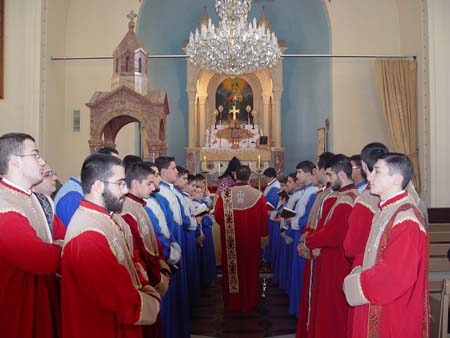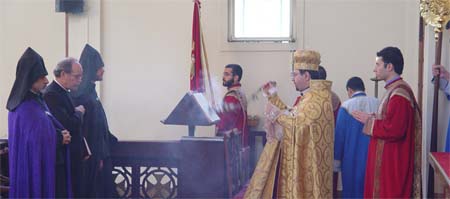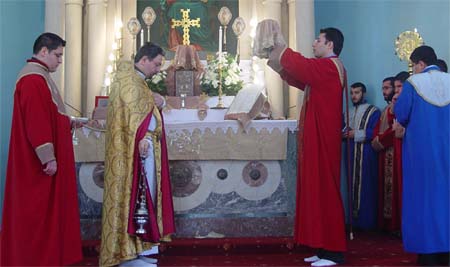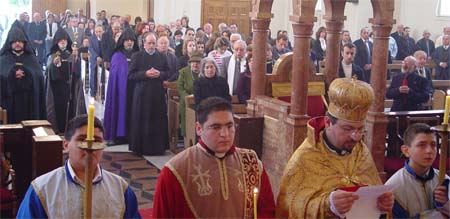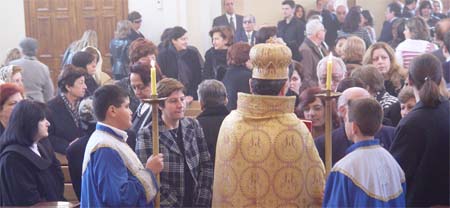 responded, “No problem at all Father. I will ask one of the deacons
tomorrow to take pictures for you.” An excellent idea this!
responded, “No problem at all Father. I will ask one of the deacons
tomorrow to take pictures for you.” An excellent idea this!At eight this morning, one of my students, Deacon Christopher (a native of Aleppo, Syria, pictured here) came to my door to collect my camera. It seems that Deacon Christopher is the official photographer at the seminary, and he does an excellent job. Familiar as he is not only with the Badarak itself, but also with the side doors, stairways, and other passage ways of the Cathedral, he glides through and around the liturgy, all rather innocuously, taking photos from angles and at moments that I simply would never have had the gumption to consider.
What follows are Deacon Christopher’s wonderful photos with explanations taken from a document on the Divine Liturgy found online at the Armenian Apostolic Church Library. Father Tatoul our celebrant this morning, is a priest of the Brotherhood of the Patriarchate of Constantinople. Fr Tatoul is now in the final stages of a three year internship at the Seminary in Bickfaya, where he is completing work on a post-ordination thesis as well as doing some teaching.
Concluding the the Sunday morning offices, the seminarians and clergy line up along the centre aisle for a final hymn. I am impressed with the enormous amounts of text and hymnody that the seminarians and clergy have committed to memory. The long closing hymn is sung boisterously, and the Cathedral, rather like a great bell, reverberates with sound. The seminarians not involved as deacons or acolytes for the Divine Liturgy, now adjourn to the choir loft to sing for the service. Deacon Berj (pictured, right) has a particularly fine tenor voice, and we are blessed with solos from him from time to time during the Badarak.
“THE PREPARATION: Before the Divine Liturgy begins the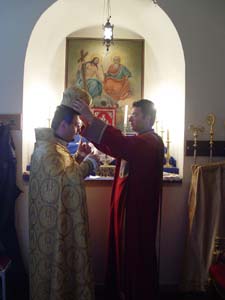 celebrant prepares himself spiritually by
reciting psalms and preparatory prayers that ask the Lord to make him worthy to
offer the Badarak. The priest then puts on his vestments. They are modeled after
both the garments worn by Jewish priests in the temple (Exodus 28) and the
attire of a king because during the Divine Liturgy the priest mystically makes
present to us Christ, who reigns with his Father in the kingdom of heaven.
‘Lord, put the helmet of salvation upon my head to fight against the powers of
the enemy, by the grace of our Lord Jesus Christ to whom is befitting glory,
dominion and honor, now and always and unto the ages of ages. Amen.’”
celebrant prepares himself spiritually by
reciting psalms and preparatory prayers that ask the Lord to make him worthy to
offer the Badarak. The priest then puts on his vestments. They are modeled after
both the garments worn by Jewish priests in the temple (Exodus 28) and the
attire of a king because during the Divine Liturgy the priest mystically makes
present to us Christ, who reigns with his Father in the kingdom of heaven.
‘Lord, put the helmet of salvation upon my head to fight against the powers of
the enemy, by the grace of our Lord Jesus Christ to whom is befitting glory,
dominion and honor, now and always and unto the ages of ages. Amen.’”
“After confessing his sins in front of the congregation the celebrant washes his hands, and enters the sanctuary (a raised stage in the Armenian tradition) and the curtain is drawn.”

“Behind the closed curtain the deacon
presents unleavened bread and wine to the priest, who blesses them with the sign
of the cross. The chalice and paten are then covered with a veil and set aside
in a niche until after the Synaxis (the “assembly” or “gathering” for the
Liturgy of the Word), until the beginning of the Eucharist proper. When the
curtain opens, the priest circles the Cathedral incensing the altars, the icons
and the people, who venerate his hand cross and ask him to pray for them saying,
‘Remember me before the immortal lamb of God.’”
“THE SYNAXIS: Passages from the Old and New Testament are read at every
Divine Liturgy. The readings and the psalms that punctuate them are always
associated with the liturgical feast or season. The Gospel reading is the focus
of this part of the Divine Liturgy. Just as in the
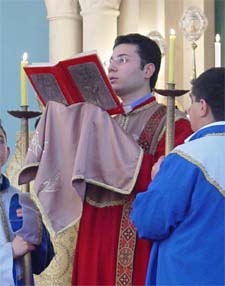 Eucharist Christ comes to us in his Body and Blood, likewise during
the Synaxis our Lord comes to us through his Word. This is clear from the
announcement of the Gospel reading when the choir responds, “Glory to you, O
Lord our God . . . God is speaking.” Chanting the Gospel is one of the
traditional functions of the ordained deacon.”
Eucharist Christ comes to us in his Body and Blood, likewise during
the Synaxis our Lord comes to us through his Word. This is clear from the
announcement of the Gospel reading when the choir responds, “Glory to you, O
Lord our God . . . God is speaking.” Chanting the Gospel is one of the
traditional functions of the ordained deacon.”
Deacon Ourardou chants the Gospel reading for this the Fifth Sunday of the (Armenian) Nativity, John 6.22-38, “Jesus said to them, ‘I am the bread of life. Whoever comes to me will never be hungry, and whoever believes in me will never be thirsty.”
“THE TRANSFER OF THE GIFTS: The Eucharist proper, the heart of the Divine Liturgy, begins with the deacon’s admonition to the unbaptized and the penitents. It is a reminder that participation in the Divine Liturgy—and membership in the Church—is a profound privilege. At the Transfer of the Gifts, the deacon carries to the priest the veiled chalice containing bread and wine. They recite alternately verses from Ps 24. The procession and psalm anticipate the revelation of Jesus Christ, the “king of glory, the Lord of hosts” in the Eucharist. The hymns accompanying the procession recall the angels, who live to worship God continuously in heaven with their own special hymn of praise, “Holy, Holy, Holy” (Is 6:3, Rev 4:8)”
“On the night before his death, Jesus joined his disciples in a final evening
meal, during which he took plain bread and wine, blessed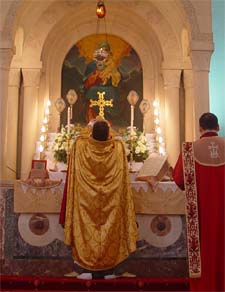 them and gave thanks; and giving them to
his disciples to eat, he proclaimed them to be his own Body and Blood, a gesture
of loving self-sacrifice and communion.”
them and gave thanks; and giving them to
his disciples to eat, he proclaimed them to be his own Body and Blood, a gesture
of loving self-sacrifice and communion.”
“He commanded that we should repeat this ritual in commemoration of him: “Do this in remembrance of me” (1Cor 11:24- 25, Lk 22:19). The communion of Christ’s Body and Blood is therefore the heart of Christian worship, and of our commemoration of Jesus Christ in the Divine Liturgy.” The words of consecration are chanted while the priest raises the bread and then the wine above his head.
“The priest’s blessing, ‘And the mercy of our great God and Savior
 Jesus Christ be with you all’ signifies the
end of the Eucharistic Prayer.” Following the deacon’s litany with its prayers
for the Church universal, the liturgy pauses for the sermon. (I’m told that the
sermon is placed here, because by this time, most of the faithful will have
arrived in church for Communion.) Following the sermon, the congregation joins
in the singing of the Lord’s Prayer “Hayr Mer”. “No gesture or ritual more
clearly demonstrates our redeemed dignity than when the faithful stand boldly
before almighty God and are privileged to call him ‘Our Father.’”
Jesus Christ be with you all’ signifies the
end of the Eucharistic Prayer.” Following the deacon’s litany with its prayers
for the Church universal, the liturgy pauses for the sermon. (I’m told that the
sermon is placed here, because by this time, most of the faithful will have
arrived in church for Communion.) Following the sermon, the congregation joins
in the singing of the Lord’s Prayer “Hayr Mer”. “No gesture or ritual more
clearly demonstrates our redeemed dignity than when the faithful stand boldly
before almighty God and are privileged to call him ‘Our Father.’”
“Those who wish to receive holy communion normally prepare themselves by
prayer and by fasting from all food and drink on the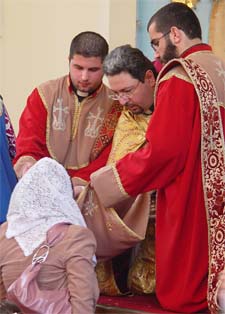 morning before receiving the sacrament.” A
penitential rite preceeds communion, while the sanctuary curtain is drawn and
the sacrament prepared for distribution. The faithful come forward to receive
communion, the women taking veils available for them at the entrance to the
chancel (lower sanctuary) area. At the Cathedral there are three communion
stations. The priests knelling on the raised sanctuary floor, are assited by
deacons or acolytes.
morning before receiving the sacrament.” A
penitential rite preceeds communion, while the sanctuary curtain is drawn and
the sacrament prepared for distribution. The faithful come forward to receive
communion, the women taking veils available for them at the entrance to the
chancel (lower sanctuary) area. At the Cathedral there are three communion
stations. The priests knelling on the raised sanctuary floor, are assited by
deacons or acolytes.
“When all have received communion the curtain closes while the priest cleans the chalice and the altar servers return all the liturgical vessels to their place. During this time the choir and people sing two hymns of thanksgiving for the grace of having been fed at the Lord’s ‘table of immortality.’”
“It is a venerable tradition in the Armenian Church for families to request prayers on the anniversary of the death of their loved ones. The celebrant reads the names of the deceased during the a brief requiem that takes place immediately following the Divine Liturgy.”
Yesterday was the feast of St. Sarkis, and there are more a few men named Sarkis on the list of the deceased — name days are important to Armenians. There are two men named Sarkis of particular importance whose names are read today, one the benefactor who paid for the construction of the Cathedral, and did so annonymously. It was only an accidently discovery of blue prints and plans after his death, that the benefactor was identified. The other Sarkis funded the building of the official residence of the Catholicos, 30 years later.
“Essentially, this prayer for the dead is that they rest in peace, that the Lord forgive them all of their sins and find them worthy of eternal life in the Father’s kingdom when Christ comes again. Praying for the dead is a proclamation of our faith in Christ’s second coming, and our hope in the resurrection of the dead. When the Armenian Church prays regularly for the dead we are reminded that this life is transient, and we are filled with hope because we believe that death is transient as well.”
“After the final blessing, the people come forward and kiss the Gospel book, saying, ‘May the Lord remember all your sacrifices.’ The priest responds, ‘May God grant to you according to your heart.’” And so concludes a remarkable and glorious celebration of God’s powerful love breaking through into our lives with majesty and grace.
Thank you Deacon Christopher for so many wonderful photos!











